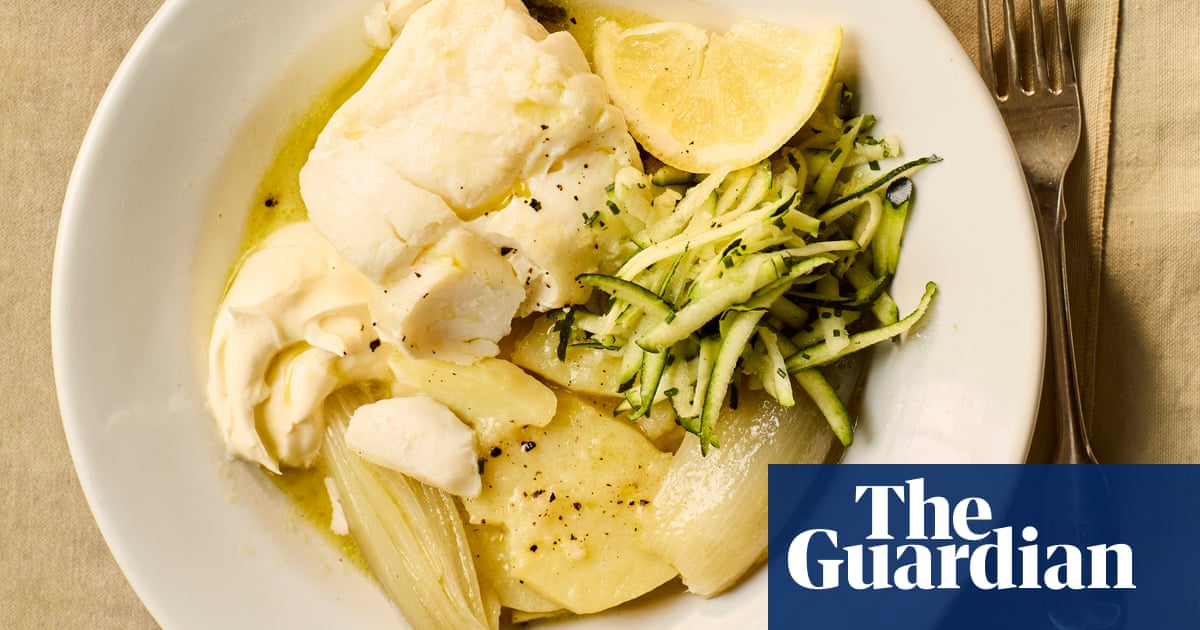There’s something quietly luxurious about gently poaching fish in good olive oil and lemon. It’s the sort of cooking that feels generous but effortless; everything simmers away in one big pan, and produces a sauce that’s rich and thick from the potato starch but lemony and fresh-tasting, too. I also often find myself craving an entire cucumber for lunch, so I love today’s salad for its simplicity and for its big flavours. I really enjoy writing recipes that I believe people will come back to again and again, and I think this is definitely one of those.
I love serving this with a simple courgette salad to cut through the richness, as well as a dollop of creme fraiche, if you fancy it. This is a perfect lunch or dinner when you want things to feel a bit special without any drama. I haven’t added any extra herbs, so the dish has a cleaner flavour, but if you’d like to add some parsley, chives or mint, they’d be a great addition.
Prep10 minCook30 minServes4
150mlextra-virgin olive oil2 bay leaves, or a few thyme sprigs1 lemon, 2-3 slices cut off, the rest juiced, plus extra lemon wedges to serveSea salt and black pepper4–5 medium cyprus potatoes, or 400g new potatoes –I peel them, so they have that clean, waxy texture, but if you prefer them unpeeled, that’s fine, too6 small banana shallots,peeled and trimmed4 thick sustainably-sourced cod fillets, or hake, haddock or any firm white fish2 courgettesCreme fraiche, to serve (optional)
Pour the olive oil and 600ml water into a wide, high-sided pan (about 28cm), then add the bay leaves, a few slices of lemon and a good pinch of salt. Slice the potatoes into 1½cm-thick coins, halve the shallots lengthways, then drop them into the pan, too.
Bring to a gentle boil and cook for eight to 10 minutes, until the potatoes and shallots are just tender. Make four indents in the mix for the fish fillets, then nestle them in; the liquid needs to come about halfway up the fish, so if need be top up with a splash more water.
Cut out a circle of baking paper to fit the pan, then lay it over the fish and vegetables. Turn down the heat to medium and leave to bubble gently for six to eight minutes, depending on the thickness of the fish. The sauce should have reduced slightly, and the starch from the potatoes will have thickened it; if it still looks a bit watery, carefully lift out the fish and potatoes, and simmer the sauce for a few minutes more to reduce.
Meanwhile, grate the courgettes into a bowl and season with salt, pepper and the juice of the remaining lemon.
Serve everything straight away, topping the fish with a dollop of creme fraiche, if you fancy, and with extra lemon wedges on the side.
The Guardian aims to publish recipes for sustainable fish. Check ratings in your region:UK;Australia;US.
When testing this dish, I plopped a few spoonfuls of tinned tuna over the cucumber and celery before spooning on the yoghurt, and I’d highly recommend doing the same, so long as you’re not serving this as a side.
Prep5 minCook20 minServes4as a side
2 cucumbers4celery sticks1 unwaxed lemon25g salted butter1 generous handfulpine nuts1 heaped tsp harissaSalt and black pepper2 tbsp extra-virgin olive oil2of your favourite tins of good-qualitytuna in olive oil, drained (optional)200g natural yoghurt
Start by slicing the cucumber and celery however you like: thin rounds, half-moons or even dice. Use a vegetable peeler to pare the lemon zest into nice wide strips.
In a small saucepan on a medium heat, melt the butter with the pine nuts. As the butter melts, the pine nuts will begin to toast; keep a close eye on them, though, because you don’t want the nuts or butter to burn, although a little browning does add a lovely, nutty depth.
Once the pine nuts are golden, stir in the harissa and lemon peel, leave to bubble gently for a minute, then take off the heat. Squeeze in the juice of half the lemon and season with a little salt, if needed.
Transfer the cucumber and celery to a bowl and drizzle over the olive oil, the juice from the remaining lemon half, and season with salt and pepper. Toss to coat, then spoon on to a platter; now’s the time to add the tuna, if using. Dollop over the yoghurt, then spoon the warm harissa-pine nut butter on top. Eat straight away, while the butter is still warm.
Kitty Coles’ latest book, Make More with Less: Foolproof Recipes to Make Your Food go Further, is published by Hardie Grant at £22. To order a copy for £19.80, go toguardianbookshop.com
